2000 HONDA ACCORD COUPE airbag
[x] Cancel search: airbagPage 16 of 338
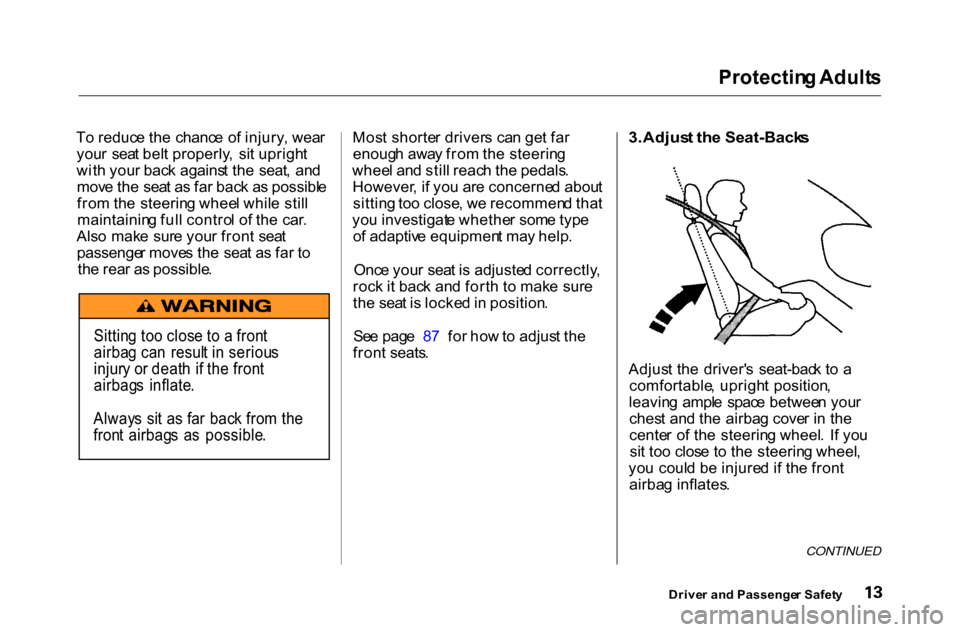
Protectin
g Adult s
T o reduc e th e chanc e o f injury , wea r
you r sea t bel t properly , si t uprigh t
wit h you r bac k agains t th e seat , an d
mov e th e sea t a s fa r bac k a s possibl e
fro m th e steerin g whee l whil e stil l
maintainin g ful l contro l o f th e car .
Als o mak e sur e you r fron t sea t
passenge r move s th e sea t a s fa r t o
th e rea r a s possible . Mos
t shorte r driver s ca n ge t fa r
enoug h awa y fro m th e steerin g
whee l an d stil l reac h th e pedals .
However , i f yo u ar e concerne d abou t
sittin g to o close , w e recommen d tha t
yo u investigat e whethe r som e typ e
o f adaptiv e equipmen t ma y help .
Onc e you r sea t i s adjuste d correctly ,
roc k i t bac k an d fort h t o mak e sur e
th e sea t i s locke d in position .
Se e pag e 8 7 fo r ho w to adjus t th e
fron t seats .
3.Adjus
t th e Seat-Back s
Adjus t th e driver' s seat-bac k t o a
comfortable , uprigh t position ,
leavin g ampl e spac e betwee n you r
ches t an d th e airba g cove r i n th e
cente r o f th e steerin g wheel . I f yo u
si t to o clos e t o th e steerin g wheel ,
yo u coul d b e injure d i f th e fron t
airba g inflates .
CONTINUED
Drive r an d Passenge r Safet y
Sittin
g to o clos e t o a fron t
airba g ca n resul t i n seriou s
injur y o r deat h i f th e fron t
airbag s inflate .
Alway s si t a s fa r bac k fro m th e
fron t airbag s a s possible .
Page 19 of 338
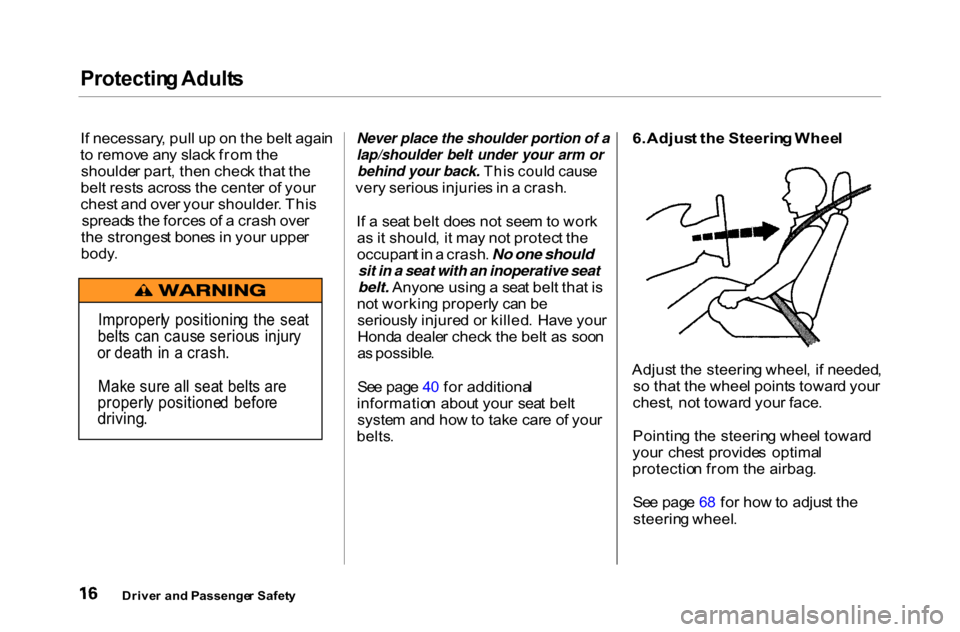
Protectin
g Adult s
I f necessary , pul l u p o n th e bel t agai n
t o remov e an y slac k fro m th e
shoulde r part , the n chec k tha t th e
bel t rest s acros s th e cente r o f you r
ches t an d ove r you r shoulder . Thi s
spread s th e force s o f a cras h ove r
th e stronges t bone s i n you r uppe r
body .
Never place the shoulder portion of a
lap/shoulder belt under your arm or
behind your back. Thi s coul d caus e
ver y seriou s injurie s in a crash .
I f a sea t bel t doe s no t see m to wor k
a s i t should , i t ma y no t protec t th e
occupan t i n a crash . No one should
sit in a seat with an inoperative seat
belt. Anyon e usin g a sea t bel t tha t i s
no t workin g properl y ca n b e
seriousl y injure d o r killed . Hav e you r
Hond a deale r chec k th e bel t a s soo n
a s possible .
Se e pag e 4 0 fo r additiona l
informatio n abou t you r sea t bel t
syste m an d ho w to tak e car e o f you r
belts .
6.Adjus
t th e Steerin g Whee l
Adjus t th e steerin g wheel , i f needed ,
s o tha t th e whee l point s towar d you r
chest , no t towar d you r face .
Pointin g th e steerin g whee l towar d
you r ches t provide s optima l
protectio n fro m th e airbag .
Se e pag e 6 8 fo r ho w to adjus t th e
steerin g wheel .
Drive r an d Passenge r Safet y
Improperl
y positionin g th e sea t
belt s ca n caus e seriou s injur y
o r deat h i n a crash .
Mak e sur e al l sea t belt s ar e
properl y positione d befor e
driving .
Page 20 of 338
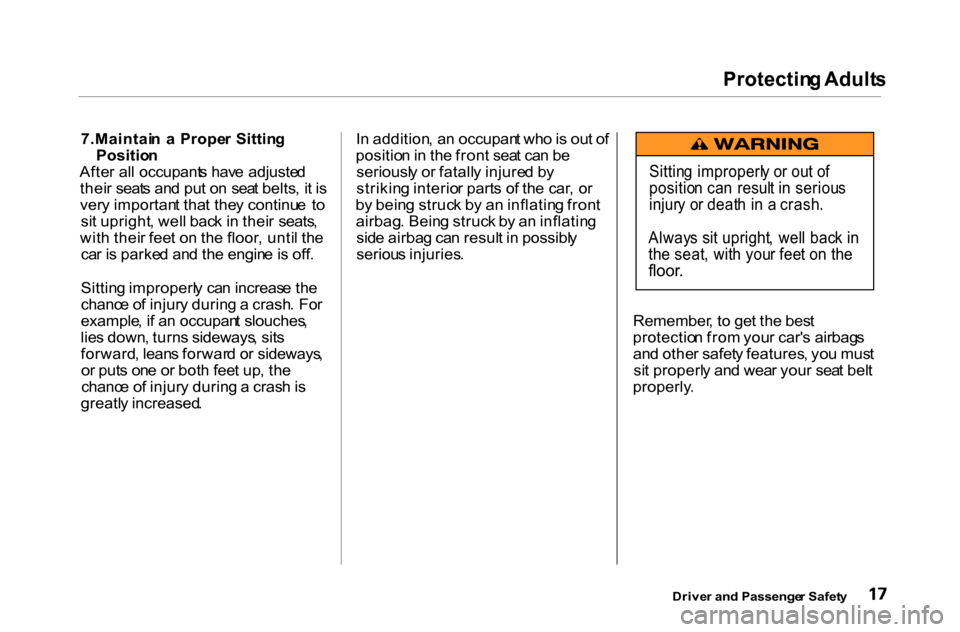
Protectin
g Adult s
7.Maintai n a Prope r Sittin g
Positio n
Afte r al l occupant s hav e adjuste d
thei r seat s an d pu t o n sea t belts , i t i s
ver y importan t tha t the y continu e t o
si t upright , wel l bac k i n thei r seats ,
wit h thei r fee t o n th e floor , unti l th e
ca r i s parke d an d th e engin e is off .
Sittin g improperl y ca n increas e th e
chanc e o f injur y durin g a crash . Fo r
example , i f a n occupan t slouches ,
lie s down , turn s sideways , sit s
forward , lean s forwar d o r sideways ,
o r put s on e o r bot h fee t up , th e
chanc e o f injur y durin g a cras h is
greatl y increased . I
n addition , a n occupan t wh o is ou t o f
positio n in th e fron t sea t ca n b e
seriousl y o r fatall y injure d b y
strikin g interio r part s o f th e car , o r
b y bein g struc k b y a n inflatin g fron t
airbag . Bein g struc k b y a n inflatin g
sid e airba g ca n resul t i n possibl y
seriou s injuries .
Remember, t o ge t th e bes t
protectio n fro m you r car' s airbag s
an d othe r safet y features , yo u mus t
si t properl y an d wea r you r sea t bel t
properly .
Drive r an d Passenge r Safet y
Sittin
g improperl y o r ou t o f
positio n ca n resul t i n seriou s
injur y o r deat h i n a crash .
Alway s si t upright , wel l bac k i n
th e seat , wit h you r fee t o n th e
floor .
Page 21 of 338
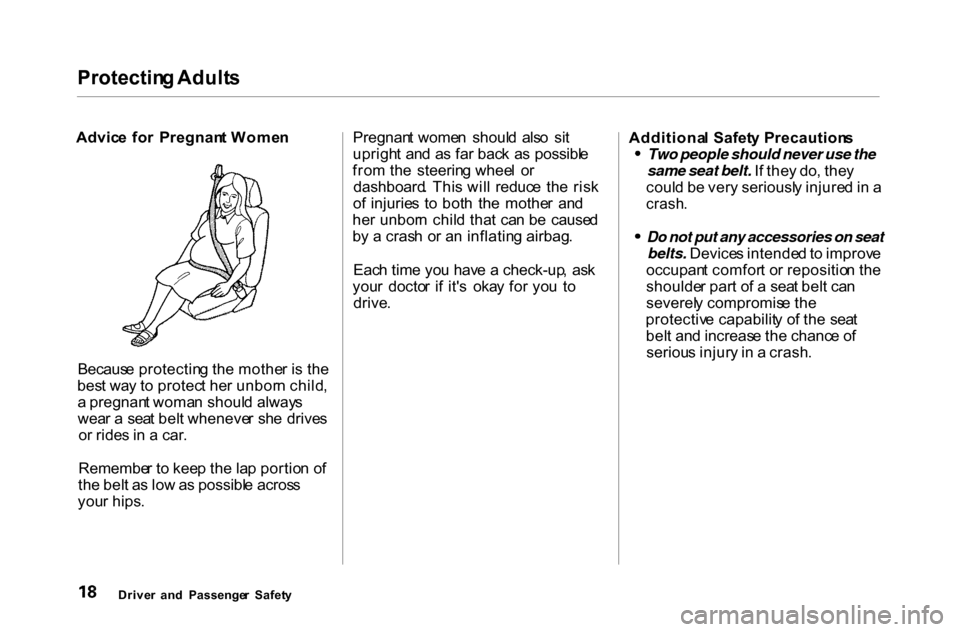
Protectin
g Adult s
Advic e fo r Pregnan t Wome n
Becaus e protectin g th e mothe r i s th e
bes t wa y t o protec t he r unbor n child ,
a pregnan t woma n shoul d alway s
wea r a sea t bel t wheneve r sh e drive s
o r ride s i n a car .
Remembe r t o kee p th e la p portio n o f
th e bel t a s lo w a s possibl e acros s
you r hips . Pregnan
t wome n shoul d als o si t
uprigh t an d a s fa r bac k a s possibl e
fro m th e steerin g whee l o r
dashboard . Thi s wil l reduc e th e ris k
o f injurie s t o bot h th e mothe r an d
he r unbor n chil d tha t ca n b e cause d
b y a cras h o r a n inflatin g airbag .
Eac h tim e yo u hav e a check-up , as k
you r docto r i f it' s oka y fo r yo u t o
drive . Additiona
l Safet y Precaution s
Two people should never use the
same seat belt. I f the y do , the y
coul d b e ver y seriousl y injure d in a
crash .
Do not put any accessories on seat
belts. Device s intende d to improv e
occupan t comfor t o r repositio n th e
shoulde r par t o f a sea t bel t ca n
severel y compromis e th e
protectiv e capabilit y o f th e sea t
bel t an d increas e th e chanc e o f
seriou s injur y in a crash .
Drive r an d Passenge r Safet y
Page 22 of 338
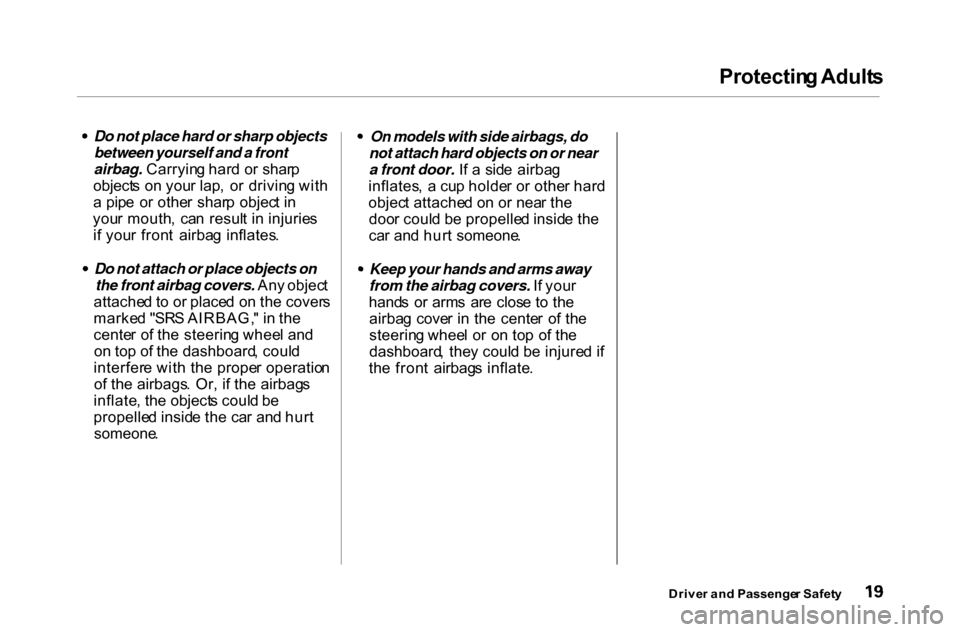
Protectin
g Adult s
Do not place hard or sharp objects between yourself and a front
airbag. Carryin g har d o r shar p
object s o n you r lap , o r drivin g wit h
a pip e o r othe r shar p objec t i n
you r mouth , ca n resul t i n injurie s
i f you r fron t airba g inflates .
Do not attach or place objects on
the front airbag covers. An y objec t
attache d t o o r place d o n th e cover s
marke d "SR S AIRBAG, " i n th e
cente r o f th e steerin g whee l an d
o n to p o f th e dashboard , coul d
interfer e wit h th e prope r operatio n
o f th e airbags . Or , i f th e airbag s
inflate , th e object s coul d b e
propelle d insid e th e ca r an d hur t
someone .
On models with side airbags, do
not attach hard objects on or near
a front door. I f a sid e airba g
inflates , a cu p holde r o r othe r har d
objec t attache d o n o r nea r th e
doo r coul d b e propelle d insid e th e
ca r an d hur t someone .
Keep your hands and arms away
from the airbag covers. I f you r
hand s o r arm s ar e clos e t o th e
airba g cove r i n th e cente r o f th e
steerin g whee l o r o n to p o f th e
dashboard , the y coul d b e injure d i f
th e fron t airbag s inflate .
Driver an d Passenge r Safet y
Page 24 of 338
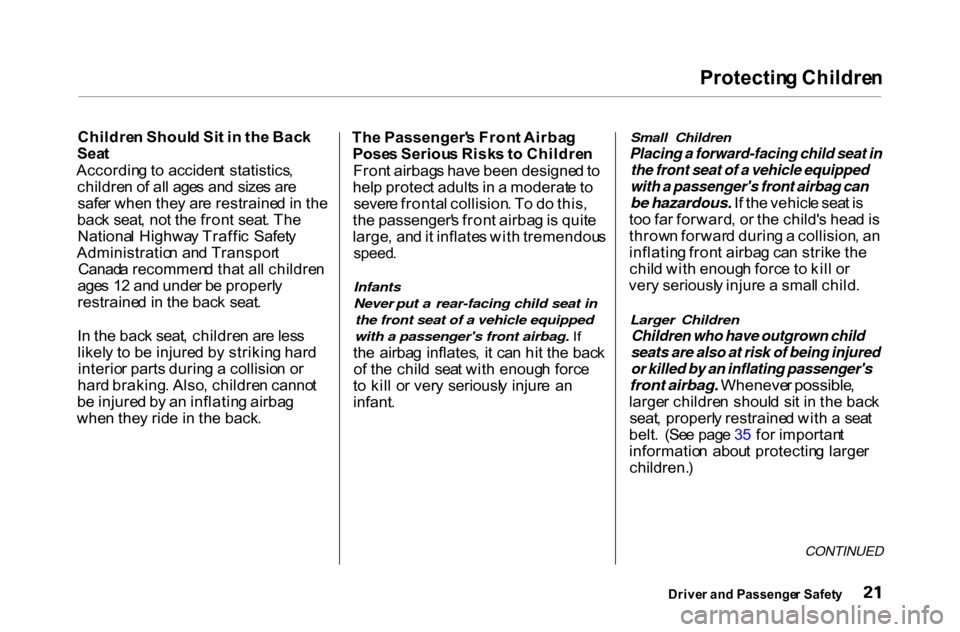
Protectin
g Childre n
Childre n Shoul d Si t i n th e Bac k
Sea t
Accordin g to acciden t statistics ,
childre n o f al l age s an d size s ar e
safe r whe n the y ar e restraine d in th e
bac k seat , no t th e fron t seat . Th e
Nationa l Highwa y Traffi c Safet y
Administratio n an d Transpor t
Canad a recommen d tha t al l childre n
age s 1 2 an d unde r b e properl y
restraine d in th e bac k seat .
I n th e bac k seat , childre n ar e les s
likel y t o b e injure d b y strikin g har d
interio r parts durin g a collisio n o r
har d braking . Also , childre n canno t
b e injure d b y a n inflatin g airba g
whe n the y rid e in th e back . Th
e Passenger' s Fron t Airba g
Pose s Seriou s Risk s t o Childre n
Fron t airbag s hav e bee n designe d to
hel p protec t adult s in a moderat e to
sever e fronta l collision . T o d o this ,
th e passenger' s fron t airba g is quit e
large , an d it inflate s wit h tremendou s
speed .
Infants
Never put a rear-facing child seat in the front seat of a vehicle equipped
with a passenger's front airbag. If
th e airba g inflates , i t ca n hi t th e bac k
of th e chil d sea t wit h enoug h forc e
t o kil l o r ver y seriousl y injur e a n
infant .
Small Children
Placing a forward-facing child seat in the front seat of a vehicle equipped
with a passenger's front airbag can
be hazardous. I f th e vehicl e sea t i s
to o fa r forward , o r th e child' s hea d is
throw n forwar d durin g a collision , a n
inflatin g fron t airba g ca n strik e th e
chil d wit h enoug h forc e t o kil l o r
ver y seriousl y injur e a smal l child .
Larger Children
Children who have outgrown child
seats are also at risk of being injured
or killed by an inflating passenger's
front airbag. Wheneve r possible ,
large r childre n shoul d si t i n th e bac k
seat , properl y restraine d wit h a sea t
belt . (Se e pag e 3 5 fo r importan t
informatio n abou t protectin g large r
children. )
CONTINUED
Drive r an d Passenge r Safet y
Page 26 of 338
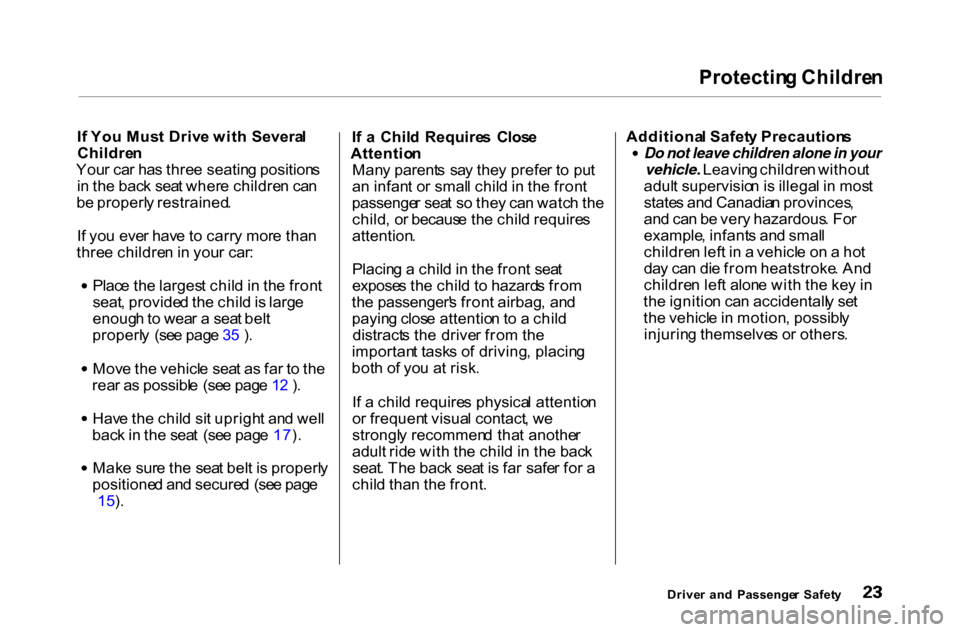
Protectin
g Childre n
I f Yo u Mus t Driv e wit h Severa l
Childre n
You r ca r ha s thre e seatin g position s
i n th e bac k sea t wher e childre n ca n
b e properl y restrained .
I f yo u eve r hav e t o carr y mor e tha n
thre e childre n in you r car :
Plac e th e larges t chil d in th e fron t
seat , provide d th e chil d is larg e
enoug h to wea r a sea t bel t
properl y (se e pag e 3 5 ) .
Mov e th e vehicl e sea t a s fa r t o th e
rea r a s possibl e (se e pag e 1 2 ) .
Hav e th e chil d si t uprigh t an d wel l
bac k in th e sea t (se e pag e 17 ).
Mak e sur e th e sea t bel t i s properl y
positione d an d secure d (se e pag e
15 ). I
f a Chil d Require s Clos e
Attentio n
Man y parent s sa y the y prefe r t o pu t
a n infan t o r smal l chil d in th e fron t
passenge r sea t s o the y ca n watc h th e
child , o r becaus e th e chil d require s
attention .
Placin g a chil d in th e fron t sea t
expose s th e chil d t o hazard s fro m
th e passenger' s fron t airbag , an d
payin g clos e attentio n to a chil d
distract s th e drive r fro m th e
importan t task s o f driving , placin g
bot h o f yo u a t risk .
I f a chil d require s physica l attentio n
o r frequen t visua l contact , w e
strongl y recommen d tha t anothe r
adult ride wit h th e chil d in th e bac k
seat . Th e bac k sea t i s fa r safe r fo r a
chil d tha n th e front . Additiona
l Safet y Precaution s
Do not leave children alone in your
vehicle. Leavin g childre n withou t
adul t supervisio n is illega l i n mos t
state s an d Canadia n provinces ,
an d ca n b e ver y hazardous . Fo r
example , infant s an d smal l
childre n lef t i n a vehicl e o n a ho t
da y ca n di e fro m heatstroke . An d
childre n lef t alon e wit h th e ke y i n
th e ignitio n ca n accidentall y se t
th e vehicl e in motion , possibl y
injurin g themselve s o r others .
Drive r an d Passenge r Safet y
Page 29 of 338
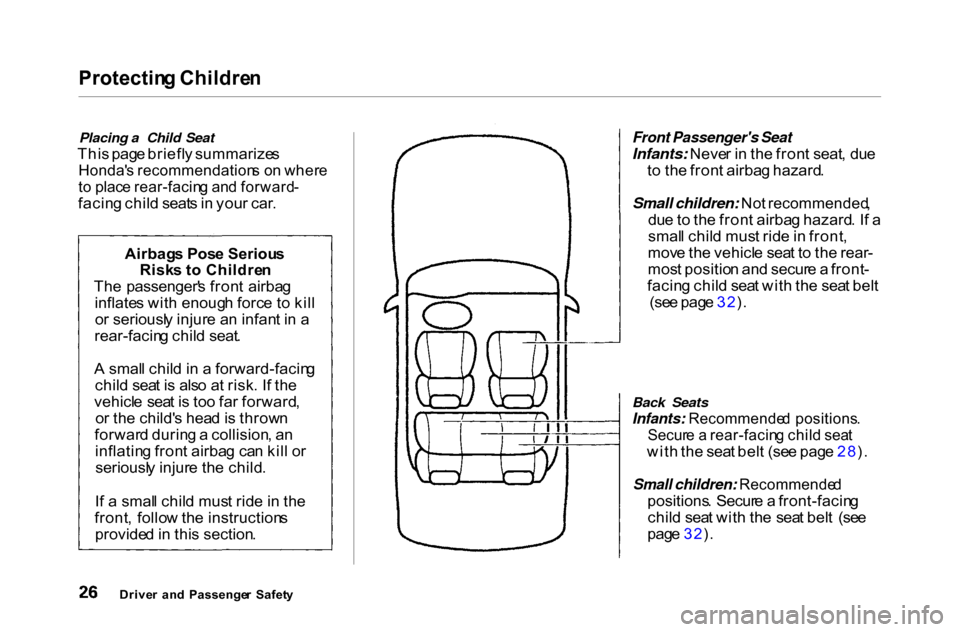
Protectin
g Childre n
Placing a Child Seat
Thi s pag e briefl y summarize s
Honda' s recommendation s o n wher e
t o plac e rear-facin g an d forward -
facin g chil d seat s in you r car .
Front Passenger's Seat
Infants: Neve
r i n th e fron t seat , du e
t o th e fron t airba g hazard .
Small children: No t recommended ,
du e to th e fron t airba g hazard . I f a
smal l chil d mus t rid e in front ,
mov e th e vehicl e sea t t o th e rear -
mos t positio n an d secur e a front -
facin g chil d sea t wit h th e sea t bel t
(se e pag e 32 ).
Back Seats
Infants: Recommende d positions .
Secur e a rear-facin g chil d sea t
wit h th e sea t bel t (se e pag e 28 ).
Small children: Recommende d
positions . Secur e a front-facin g
chil d sea t wit h th e sea t bel t (se e
pag e 32 ).
Drive r an d Passenge r Safet y
Airbag
s Pos e Seriou s
Risk s t o Childre n
Th e passenger' s fron t airba g
inflate s wit h enoug h forc e t o kil l
o r seriousl y injur e a n infan t i n a
rear-facin g chil d seat .
A smal l chil d in a forward-facin g
chil d sea t i s als o a t risk . I f th e
vehicl e sea t i s to o fa r forward ,
o r th e child' s hea d is throw n
forwar d durin g a collision , a n
inflatin g fron t airba g ca n kil l o r
seriousl y injur e th e child .
I f a smal l chil d mus t rid e in th e
front , follo w th e instruction s
provide d in thi s section .